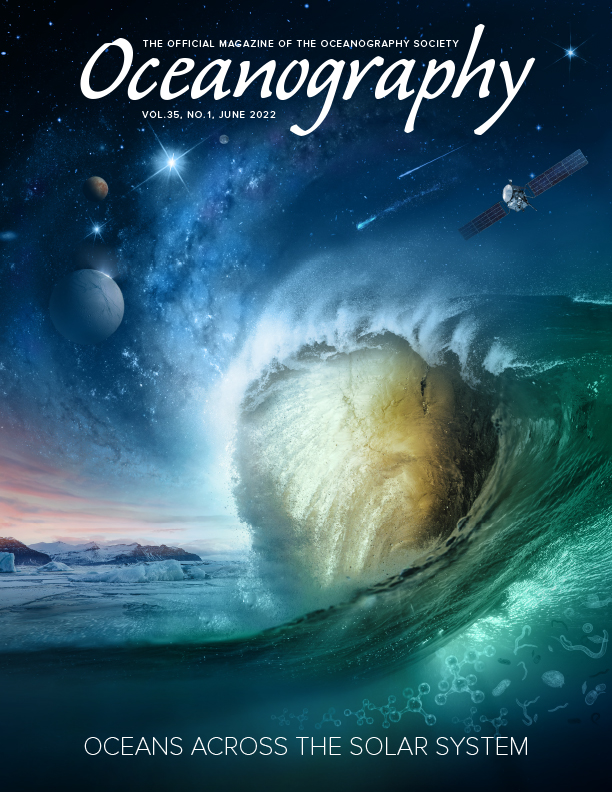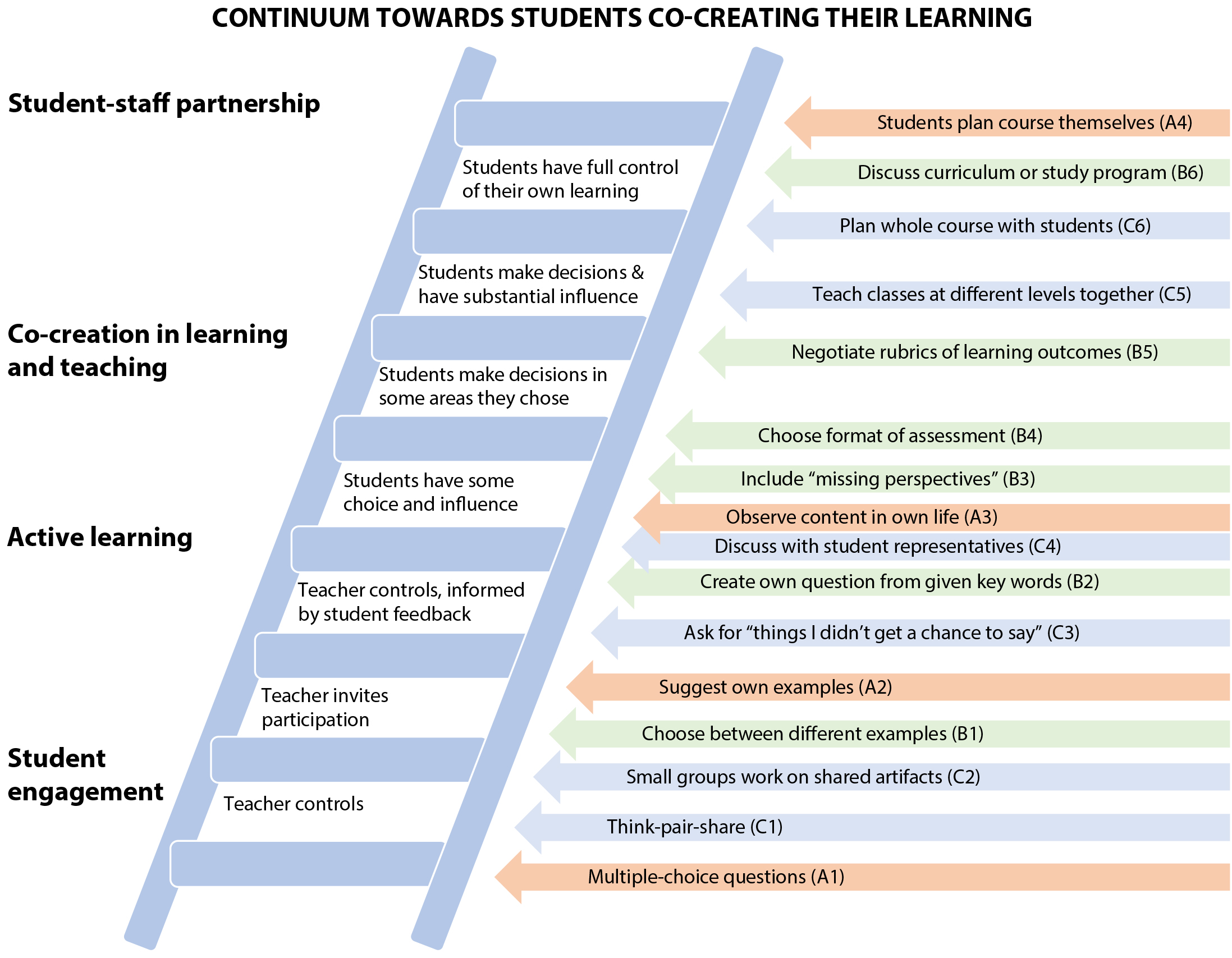First Paragraph
Using active methods to involve students in teaching improves student learning (Deslauriers et al., 2011, 2019; Freeman et al., 2014). For many teachers, breaking up a lecture with multiple choice questions and peer instruction has become an integral part of their teaching (Stains et al., 2018). We suggest involving students in creating the framework in which they learn together with their teachers (Cook-Sather et al., 2014; Bovill, 2020). Teaching then becomes more inclusive, and students try out new roles that support them in becoming more independent, secure, and responsible (Bovill, 2020). Co-creation gives students the chance to feel competent both in class and in their lives, as formative interactions make taught content more relevant to them (Boston, 2002; Black and William, 2009). Experiencing competency, autonomy, and relatedness is what makes intrinsic motivation possible (Deci and Ryan, 2000). It is thus not surprising that co-creation enhances learning and leads to more positive interactions between students and teachers (Bovill, 2020; Kaur and Noman, 2020).
Here, we present methods that we use in teaching undergraduate oceanography majors in classes of up to 35 students. The methods are easy to implement and contribute to a shared responsibility for learning. In Figure 1, these methods are placed along the continuum from engaging students to student-staff partnership, suggesting a progression from very simple and “safe” toward more advanced methods. The arrows on the right-hand side of Figure 1 represent concrete examples of co-creation described here, organized in three topics—experiencing competence (A), autonomy (B), and relatedness (C)—color-coded for easier identification. More information on all methods mentioned is provided on a website that complements this article (https://mirjamglessmer.com/co-creation-in-oceanography/).
|
|
Experience Competence: Relating Course Content to Students’ Everyday Experiences (A)
An easy way to engage students with materials discussed in class is to relate the content to questions the students encounter in their everyday lives. Take the example of heat fluxes. Instead of asking a classical multiple-choice question on the relative size of latent and sensible heat fluxes under certain conditions, why not ask students how to best cool down a beverage on the beach? Would it be by wrapping it in a wet towel, by suspending it in the water, or by digging it into the sand? (See Figure 1, A1.) It is not necessary that teachers come up with examples related to what students care about. They could instead involve students in the creation of practice tasks by presenting their own examples of where they encounter heat fluxes in their daily lives (Figure 1, A2).
Another way to connect content to students’ lives is to send them on expeditions with the goal of observing and documenting examples of class topics (Glessmer, 2020; Figure 1, A3). Waves can be found everywhere: in the sink, the storm drain, a puddle, a fountain, a lake, in clouds. Clouds are also useful for providing examples of phase changes, the influence of topography on geophysical flows, density stratifications, the water cycle, and more. And for oceanic mixing processes, only coffee and milk are needed (Glessmer, 2021).
Experience Autonomy: Giving Students Choices (B)
If different topics could be covered in a class, or different cases could be presented, in order to learn about a particular concept, the instructor might let students choose between different options (Figure 1, B1). Students could, for example, discuss an evaporation basin like the Mediterranean, or a precipitation basin like the Baltic Sea, to work toward understanding both parts of the water cycle.
For assignments like essays or lab reports, students can pose their own research questions based on a selection of keywords (Figure 1, B2). For example, related to data from a given fjord, the keywords “mixed layer,” “wind,” and “precipitation” could become: How long does a rain event stay visible in the salinity of the mixed layer? How does wind influence mixed layer depth? What type of wind event do we need to break through a freshwater layer? Of course, the teacher can influence final choices before the students start working on self-defined topics—but how much more motivating is it for students to work on their own questions compared to a question provided by their teacher?
There is also the option to leave one or two sessions on the course schedule open in order to include what students identify as a “missing perspective” on the topic (Figure 1, B3). For example, in a course on wave physics, it might be how to harvest wave and tidal energy, or how to protect coastal regions against storm surges, or how to identify the best surf spots depending on weather conditions. Knowing what topics students really care about, the teacher could then prepare lessons, invite guests, or let students facilitate.
Another idea might be to let students choose the format for an assessment (Figure 1, B4), possibly with an additional written reflection covering aspects that were not feasible to include in the students’ chosen format. They could choose between a classical report or convey the same information in a video, podcast, or Instagram story (even more motivating if the university’s social media team lets them do a take-over!). To fairly judge the academic quality of all the different formats, the assessment rubric can be negotiated with the students (Figure 1, B5). Given certain non-negotiable learning outcomes, how would students want to weight them within constraints the teacher sets? How much should things like figure captions or overall structure count compared to the quality of the hypothesis or the discussion? And are there any additional learning outcomes or artistic merits that should be included (to a degree negotiated and agreed upon)?
Experience Relatedness: Reducing Barriers to Contribution and Fostering Exchange (C)
To increase student participation in class, it may be useful to provide the opportunity for small-group discussions before questions are answered out loud in front of a large group (e.g., through think-pair-share; Kaddoura, 2013; Figure 1, C1). When students work in small groups, they can cooperate to create means for working together (Figure 1, C2) such as a shared online document where each group works on its own slide, or on whiteboards in in-person settings. Students take notes, both on the main points being raised and on the most interesting points that they want to bring back into the plenum for later discussion. This provides the teacher with a real-time idea of what the groups are talking about without interrupting them, and allows planning for how to integrate the points the students are making into later discussion. Groups can look at other groups’ notes if they are curious or get stuck. If some students are shy or there are established roles in the groups that need breaking up, the teacher can assign roles such as group spokesperson, notetaker, or timekeeper (maybe the student who most recently celebrated a birthday or the one currently located furthest south—facts that may also provide the students with icebreaker questions).
In order to include those students in discussions who might be shy, didn’t find the right moment to contribute before the conversation had moved on, or didn’t want to derail the conversation, one could ask for “things I wanted to say but did not get the chance to” in a shared document, where individuals can contribute anonymously (Figure 1, C3). This forum is often where interesting points are brought up that can serve as openers for the next session and that might otherwise have gotten lost. And to make sure any larger issues that students might want to raise are brought up, student representatives in every course could speak to the teacher on behalf of the group (Figure 1, C4).
Co-creation can also go beyond individual courses. In our second-year lab on rotating fluid dynamics, for example, we bring in third-year students (who we train for the purpose) to facilitate the experiments by asking guiding questions (Figure 1, C5). Students in both courses learn from this: the second-year students have role models that just went through the same learning process and still remember what it was like, and the third-year students realize how much they learned within a year, and they get the opportunity to practice teaching skills (Glessmer and Daae, 2021).
Climbing the Ladder Toward Shared Responsibility
Continuing to build on these examples, one could of course climb further along the continuum toward shared responsibility, where at the top students might be invited to plan the whole course with the teacher (Figure 1, C6), to discuss the curriculum of the study program (Figure 1, B6), or to initiate courses themselves (Figure 1, A4). But reaching the top of the ladder does not have to be the goal, and trying one small step at a time offers a good approach for making sure everyone—teacher and students—is comfortable with the process. Ultimately, we think of our students as partners, and we want to engage in “a collaborative, reciprocal process through which all participants have the opportunity to contribute equally, although not necessarily in the same ways, to curricular or pedagogical conceptualizations, decision-making, implementation, investigation, or analysis” (Cook-Sather et al., 2014). We invite you to join us!


